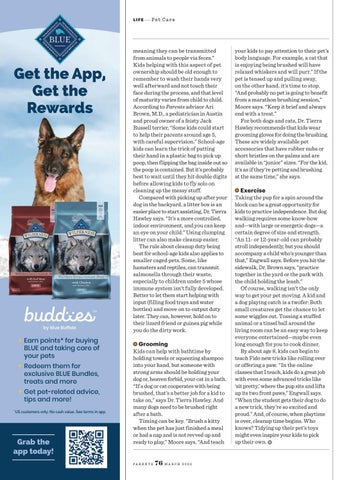L I F E Ñ Pe t C a r e
Get the App, Get the Rewards
Earn points* for buying BLUE and taking care of your pets Redeem them for exclusive BLUE Bundles, treats and more Get pet-related advice, tips and more! *US customers only. No cash value. See terms in app.
Grab the app today!
meaning they can be transmitted from animals to people via feces.” Kids helping with this aspect of pet ownership should be old enough to remember to wash their hands very well afterward and not touch their face during the process, and that level of maturity varies from child to child. According to Parents advisor Ari Brown, M.D., a pediatrician in Austin and proud owner of a feisty Jack Russell terrier, “Some kids could start to help their parents around age 5, with careful supervision.” School-age kids can learn the trick of putting their hand in a plastic bag to pick up poop, then flipping the bag inside out so the poop is contained. But it’s probably best to wait until they hit double digits before allowing kids to fly solo on cleaning up the messy stuff. Compared with picking up after your dog in the backyard, a litter box is an easier place to start assisting, Dr. Tierra Hawley says. “It’s a more controlled, indoor environment, and you can keep an eye on your child.” Using clumping litter can also make cleanup easier. The rule about cleanup duty being best for school-age kids also applies to smaller caged pets. Some, like hamsters and reptiles, can transmit salmonella through their waste, especially to children under 5 whose immune system isn’t fully developed. Better to let them start helping with input (filling food trays and water bottles) and move on to output duty later. They can, however, hold on to their lizard friend or guinea pig while you do the dirty work. Grooming Kids can help with bathtime by holding towels or squeezing shampoo into your hand, but someone with strong arms should be holding your dog or, heaven forbid, your cat in a bath. “If a dog or cat cooperates with being brushed, that’s a better job for a kid to take on,” says Dr. Tierra Hawley. And many dogs need to be brushed right after a bath. Timing can be key. “Brush a kitty when the pet has just finished a meal or had a nap and is not revved up and ready to play,” Moore says. “And teach
PA R E N T S
76 M A R C H
2022
your kids to pay attention to their pet’s body language. For example, a cat that is enjoying being brushed will have relaxed whiskers and will purr.” If the pet is tensed up and pulling away, on the other hand, it’s time to stop. “And probably no pet is going to benefit from a marathon brushing session,” Moore says. “Keep it brief and always end with a treat.” For both dogs and cats, Dr. Tierra Hawley recommends that kids wear grooming gloves for doing the brushing. These are widely available pet accessories that have rubber nubs or short bristles on the palms and are available in “junior” sizes. “For the kid, it’s as if they’re petting and brushing at the same time,” she says. Exercise Taking the pup for a spin around the block can be a great opportunity for kids to practice independence. But dog walking requires some know-how and—with large or energetic dogs—a certain degree of size and strength. “An 11- or 12-year-old can probably stroll independently, but you should accompany a child who’s younger than that,” Engwall says. Before you hit the sidewalk, Dr. Brown says, “practice together in the yard or the park with the child holding the leash.” Of course, walking isn’t the only way to get your pet moving. A kid and a dog playing catch is a twofer: Both small creatures get the chance to let some wiggles out. Tossing a stuffed animal or a tinsel ball around the living room can be an easy way to keep everyone entertained—maybe even long enough for you to cook dinner. By about age 8, kids can begin to teach Fido new tricks like rolling over or offering a paw. “In the online classes that I teach, kids do a great job with even some advanced tricks like ‘sit pretty,’ where the pup sits and lifts up its two front paws,” Engwall says. “When the student gets their dog to do a new trick, they’re so excited and proud.” And, of course, when playtime is over, cleanup time begins. Who knows? Tidying up their pet’s toys might even inspire your kids to pick up their own.











